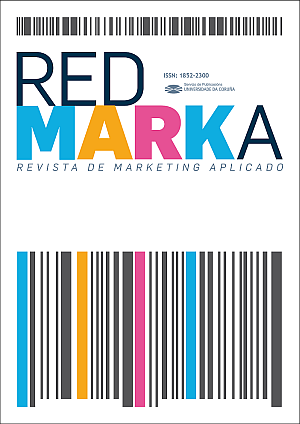Patterns of authority and influence in instagram for the management of organizational communication and personal brands
Main Article Content
Abstract
With more than 800 million active users every month, Instagram has become the fashion network for the distribution of audiovisual content, especially photography and short video. The relevance of the network for the exploitation of personal brands is demonstrated by the examples of influencers that were born on Instagram and now act as prescribers of other commercial brands.
However, how can organizations take advantage of this network to get closer to the public and improve engagement levels? In this paper we analyze the possibilities and resources offered by Instagram for the management of communication in organizations, differentiating between the practices of particular users and the professional treatment of a brand. Special attention is paid to the potential of the self-destructive content (Instagram stories) and its relevance for using in community management planning. Wedescribe and analyze the patterns and management models that denote authority and influence so, on the other hand, the most notoriety accounts in the network are examined. It is concluded by evaluating the analytical standards that must be considered for the measurement of audiences, of the return and of the investment made.
Keywords:
Downloads
Article Details
References
Abidin, C. (2016). Visibility labour: Engaging with Influencers' fashion brands and #OOTD advertorial campaigns on Instagram. Media International Australia, 161(1), 86-100. DOI: https://doi.org/10.1177/1329878X16665177
Agustina, M. & Steinberg, L. (2017). Youtuber discursivity: Affection, narratives and socialization strategies in Internet communities. Revista Mediterránea de Comunicación, 8(2), 171-188. DOI: https://doi.org/10.14198/MEDCOM2017.8.2.12
Alp, Z. Z. & Oguducu, S. G. (2018). Identifying topical influencers on twitter based on user behavior and network topology. Knowledge-Based Systems, 141, 211-221. DOI: https://doi.org/10.1016/j.knosys.2017.11.021
De Veirman, M., Cauberghe, V. & Hudders, L. (2017). Marketing through Instagram influencers: the impact of number of followers and product divergence on brand attitude. International Journal of Advertising, 36(5), 798- 828. DOI: https://doi.org/10.1080/02650487.2017.1348035
Engelstaetter, B. & Ward, M. R. (2018). Strategic timing of entry: evidence from video games. Journal of Cultural Economics, 42(1), 1-22. DOI: https://doi.org/10.1007/s10824-016-9276-7
Galeano, S. (2018). Cuáles son las redes sociales con más usuarios del mundo (2018). Marketing4ecommerce. Recuperado el 15 de febrero de 2018 de https://marketing4ecommerce.net/cuales-redes-sociales-mas-usuarios-mundo-2018/
García, A., López-de-Ayala, M.C. & Catalina, B. (2013). Hábitos de uso en Internet y en las redes sociales de los adolescentes españoles. Comunicar 2013, XXI(41), 195-204. DOI: https://doi.org/10.3916/C41-2013-19
Garmendia, M., Garitaonandia, C., Martínez, G. & Casado, M. (2012). Riesgos y seguridad en Internet: los menores españoles en el contexto europeo. Quaderns del CAC 38, XV (1), 37-44.
Godwin, H. T., Khan, M. & Yellowlees, P. (2017). The Educational Potential of YouTube. Academic Psychiatry, 41(6), 823-827. DOI: https://doi.org/10.1007/s40596-017-0809
Gruner, R. L. & Power, D. (2018). To integrate or not to integrate? Understanding B2B social media communications. Online Information Review, 42(1), 73-92. DOI: https://doi.org/10.1108/OIR-04-2016-0116
Gupta, H., Lam, T.; Pettigrew, S. & Tait, R. (2018). Alcohol marketing on YouTube: exploratory analysis of content adaptation to enhance user engagement in different national contexts. BMC Public Health, 18, artículo 14. DOI: https://doi.org/10.1186/s12889-018-5035-3
Horta, P. M., Rodrigues, F. T. & Dos Santos, L. C. (2018). Ultra-processed food product brands on Facebook pages: highly accessed by Brazilians through their marketing techniques. Public Health Nutrition, 1-5. DOI: https://doi.org/10.1017/S1368980018000083
IAB (2017). Estudio Anual de Redes Sociales. Recuperado el 12 de febrero de 2018 http://iabspain.es/wpcontent/uploads/iab_estudioredessociales_2017_vreducida.pdf
Mamani, M. J., do Nascimento, D. E., Rocha, S. H. & Santoyo, A. H. (2017). Analysis of addiction test applied to adolescents, users of digital social media. Revista Espacios, 38(24). Recuperado de http://www.revistaespacios.com/a17v38n24/17382406.html
Mullo-Lopez, A.-H. & Yaguana-Romero, H.-A. (2017). The prosumer in the construction of the radio speech: analysis of the case of the Ecuadorian radios of Cotopaxi and Tungurahua. Revista Mediterránea de Comunicación, 8(2), 241-260. DOI: https://doi.org/10.14198/MEDCOM2017.8.2.15
Pathcin, J. W., & Hinduja, S. (2010). Trends in Online Social Networking: Adolescent Use of MySpace over Time. New Media & Society, 12(2), 197-216. DOI: https://doi.org/10.1177/1461444809341857
Planells, J. A. (2017). Video games and the crowdfunding ideology: From the gamer-buyer to the prosumer-investor. Journal of Consumer Culture, 17(3), 620-638. DOI: https://doi.org/10.1177/1469540515611200
Rodríguez, M. I., Paino, A., Ruiz, Y. & Jiménez, L. (2017). Cambios en los modelos persuasivos: la nueva publicidad en tiempo real a través de estrategias narrativas transmedia. Estudio de caso de la campaña publicitaria de Tous, Tender Stories. adComunica. Revista Científica de Estrategias, Tendencias e Innovación en Comunicación, 14, 27-50.
Seyfi, M. & Soydas, A. U. (2017). Instagram Stories from the perspective of narrative transportation theory. Turkish Online Journal of Design Art and Communication, 7(1), 47-60. DOI: https://doi.org/10.7456/10701100/005
Sixto, J. (2017). Os contidos autodestruibles, unha nova forma de storytelling para a comunicación organizacional. En Ledo, M.; Campos, F.; Toural, C.; Rúas, X.; Rodríguez, A. I.; Costa, C.; Salgueiro, M. & Rodríguez, M. (eds.) (2017). Actas do I Internacional de AGACOM. Alén das Fronteiras: Redes na Diversidade, 385-398. Santiago de Compostela: Universidade de Santiago de Compostela.






